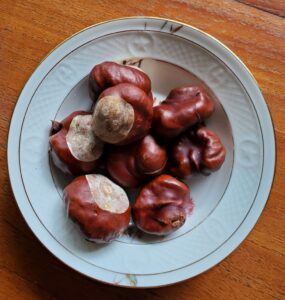Since moving to the Northwest, I’ve found a number of friends who, like me, hail from Ohio. One is Heidi, who not only shares my Ohio origins, but also my interest in genealogy (and yoga). A while ago, Heidi gave a talk at Seattle Genealogical Society about the history of Ohio, the Buckeye State, at which time she passed around “buckeyes,” a delicious peanut butter and chocolate dessert (click on the link for the recipe).
 Growing up in Ohio, it was fun to collect and play with buckeyes, but they were inedible as a nut, and seemed to my inexpert botanical eye as pretty useless. Boy, was I wrong.
Growing up in Ohio, it was fun to collect and play with buckeyes, but they were inedible as a nut, and seemed to my inexpert botanical eye as pretty useless. Boy, was I wrong.
While researching about early settlers to Ohio and the landscape they found, I came across the Historical Collection From Columbiana and Fairfield Township, in which Ray Hum explains reasons why Ohio is called the Buckeye State:
The buckeye, whose Indian name was “hetuck,” meaning “the eye of the buck,” was indeed a friend to the pioneers. Growing in the richest soil, it proved easiest to clear. When the first log cabins were hurriedly erected, the lightness and softness of he wood made it invaluable to the settlers because of the shortage of labor and tools.
… Sugar was unknown in[the Ohio] region, and residents relied on the sugar maple for sweetening. Here, also, the buckeye proved its usefulness. Not only did it grow side by side with the sugar maple, but it also furnished the best wood from which the evaporating troughs could be made.
Hats were made from its fibers; trays for pone and Johnny cake, the venison trencher, the noggin, the spoon and white bowl for mush and milk were carved from its trunk.
The buckeye, because of its slow burning, was considered unfit for fuel. But it was used as a backlog for the cabin fires. When it was finally burnt, it produced more alkaline than any other wood. The bark, prepared properly, was said to be effective in the cure of ague and fever; but, if improperly prepared, it proved to be a violent emetic.
In the absence of soap, the buckeye was an able substitute. The inner covering of the nut, when grated, was found to be soapy. When the powder was washed, large quantities of starch could be obtained, which, in case of famine, could be used as food. But the water used for this washing holds in solution a medicinal agent which, if swallowed, proves poisonous.
Of all the trees in the woods, none is so hard to kill as the buckeye. The deepest girdling does not kill it, and even after it is cut down and its logs are used to build cabins it will send out young branches — telling all the world that buckeyes are not easily conquered.
The abundance of the buckeye tree, the luxuriance of its foliage, its richly colored nuts, and its adaptability to the needs of the early settlers readily explain why Ohioans are called “Buckeyes.”
